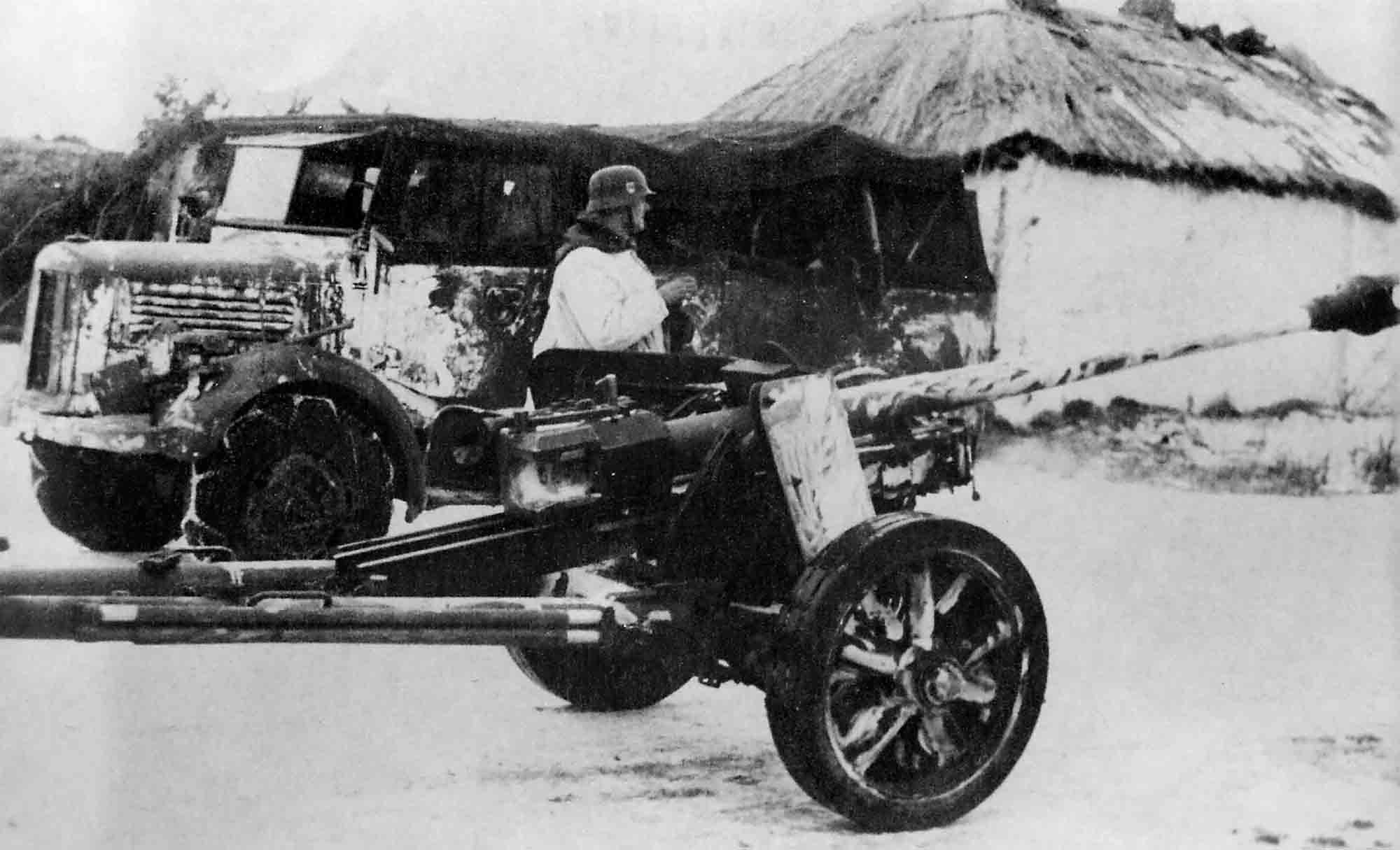
A Waffen-SS anti-tank gunner stands next to his 5cm PaK 38 during early winter operations on the Eastern Front in 1942. The weapon has received some winter white camouflage paint to help conceal it in the snow.
By the beginning of the summer of 1942 the Wehrmacht opened up a new offensive to the south of Russia, but not all the divisions were fully equipped and ready for combat. Some of the older units did not have their losses from the winter offensive of 1941 replaced. Worn out and depleted divisions were relegated to Army Group North or Army Group Centre where they were hastily deployed for a series of defensive actions. The best-equipped divisions were shifted to Army Group South for operations through the Caucasus.
It was apparent that the Wehrmacht’s ability to combat some of the Soviet tanks was still inadequate, in spite of this being their second year fighting on the Eastern Front. The Germans needed more powerful anti-tank guns that were mobile. In the field they had the punchy 7.5cm PaK 40, and a large number of captured Soviet 76mm F-22 Model 1936 divisional field guns were widely available for modification. This captured Soviet weapon had already been converted into the 7.62cm PaK 36(r) with a few simple changes, such as the reaming out of the chamber to suit a standard German cartridge case, notably that of the 7.5cm PaK 40, moving the elevating hand-wheel to the left side of the carriage, and installing a muzzle brake. Now this Soviet gun was going to be modified into a fast-moving German anti-tank gun. Already the Germans had adapted the Panzerja¨ger I to provide mobility for a heavier gun against enemy tanks. Now an interim solution was needed to deal with the urgent threat of being overrun by new Soviet T-34s and KV-1s. It was thus decided to adapt captured French vehicles such as the Lorraine, and the German Pz.Kpfw.II and 38(t) as the basis for makeshift anti-tank destroyers. The result was the Marder series: the Marder I, II and III. These vehicles provided mobility for either the captured Soviet 7.62cm PaK 36(r) gun or in later versions the German 7.5cm PaK 40 anti-tank gun.
The Marder I mounted the 7.5cm PaK 40 anti-tank gun on a Lorraine chassis. Later, several other French and Polish tanks were used as the conversion base for the Marder I, including the Hotchkiss H39 and the FCM 36.
Another anti-tank vehicle to be introduced in 1942 was the second series of the Marder, the Marder II. This was based on the chassis of the Pz.Kpfw.II. There were two versions, the first mounted modified Soviet 7.62cm guns firing German ammunition, the other mounted the powerful German 7.5cm PaK 40.
In the same year, the Marder III was produced. This vehicle mounted either the Soviet 76.2mm F-22 Model 1936 divisional field guns, or the German 7.5cm PaK 40 modified on the top of the chassis of the Pz.Kpfw.38(t).
Basically, the Marder was more a gun carriage than a proper Panzerja¨ger that could exchange shells with enemy tanks. Nevertheless, they undertook sterling service for both the Wehrmacht and the Waffen-SS and operated extensively in anti-tank roles.
For the next several months both Panzerja¨ger and anti-tank battalions continued supporting the Wehrmacht and Waffen-SS’s drive East, both in defensive and offensive roles. The Panzerja¨ger units were either assigned to infantry regiments, or as a whole Abteilung (battalion) within Panzer and Panzergrenadier divisions. Independent battalions and regiments were used by corps to protect against possible tank attacks, while divisions would often position their Panzerja¨ger on the flanks or use them to support infantry advances against an enemy using tanks. When used with tanks, Panzerja¨ger would work in teams, with the crews enticing enemy tanks to fire, often disclosing their position, and engaged the enemy from mobile positions. Panzerja¨ger were regularly called upon to provide direct high explosive supporting fire to infantry by destroying machine gun and artillery positions, particularly in urban fighting.
As for the PaK units supporting the drive, their guns, usually mounted on two-wheeled carriages, were often towed into position then withdrawn and repositioned rapidly. They could also be manoeuvred into position by hand. They all fired high-explosive and solid armour piercing rounds effective at medium range.

A Waffen-SS anti-tank gunner stands next to his 5cm PaK 38 during early winter operations on the Eastern Front in 1942. The weapon has received some winter white camouflage paint to help conceal it in the snow.
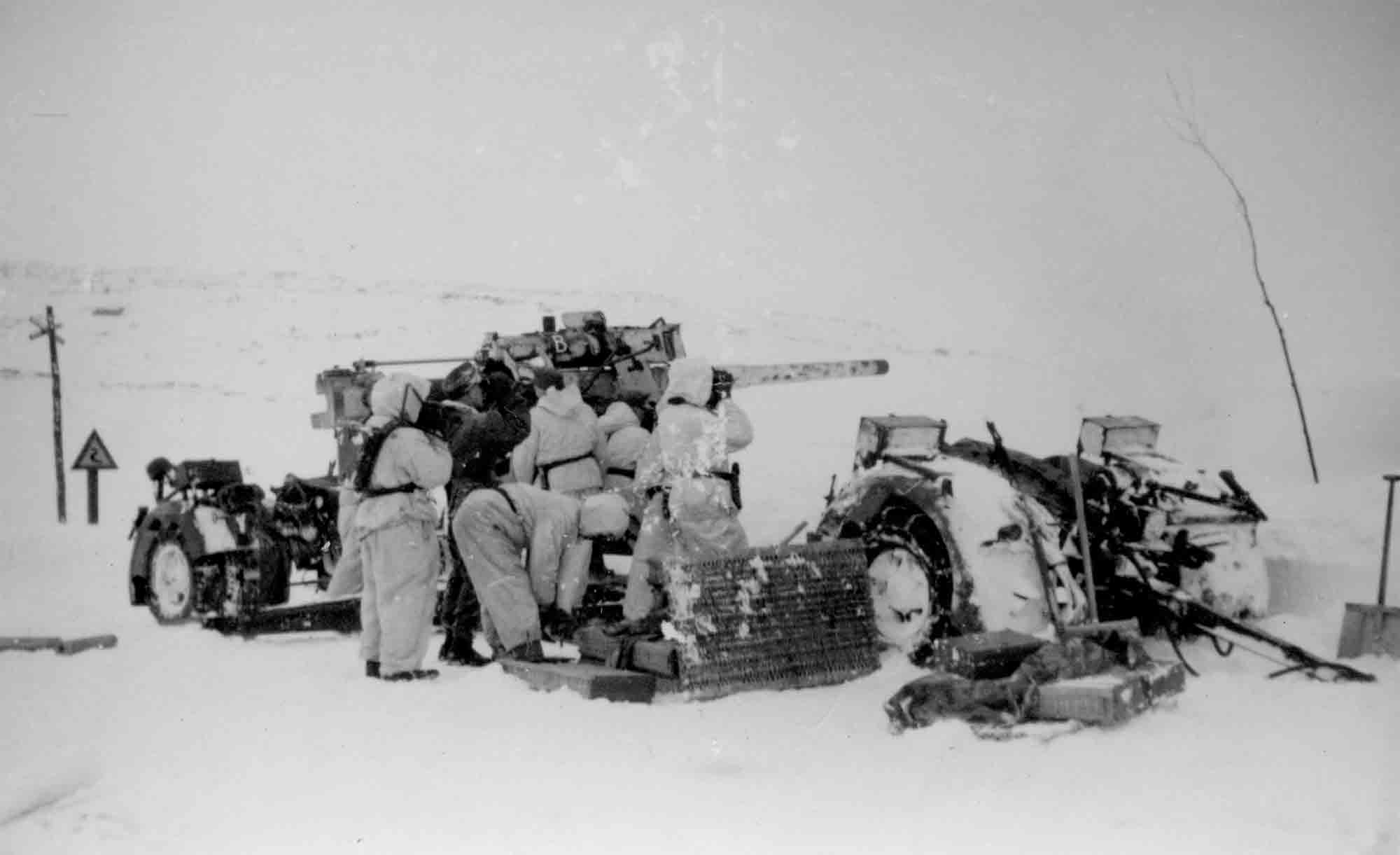
While most anti-tank weapons were built purely to combat enemy armour, the Germans used the 8.8cm FlaK gun against ground targets as well, as both of these photographs depict. Both barrels have been lowered into a horizontal position on a cruciform platform mount. Note the Sd.Ah.201 limber units nearby.
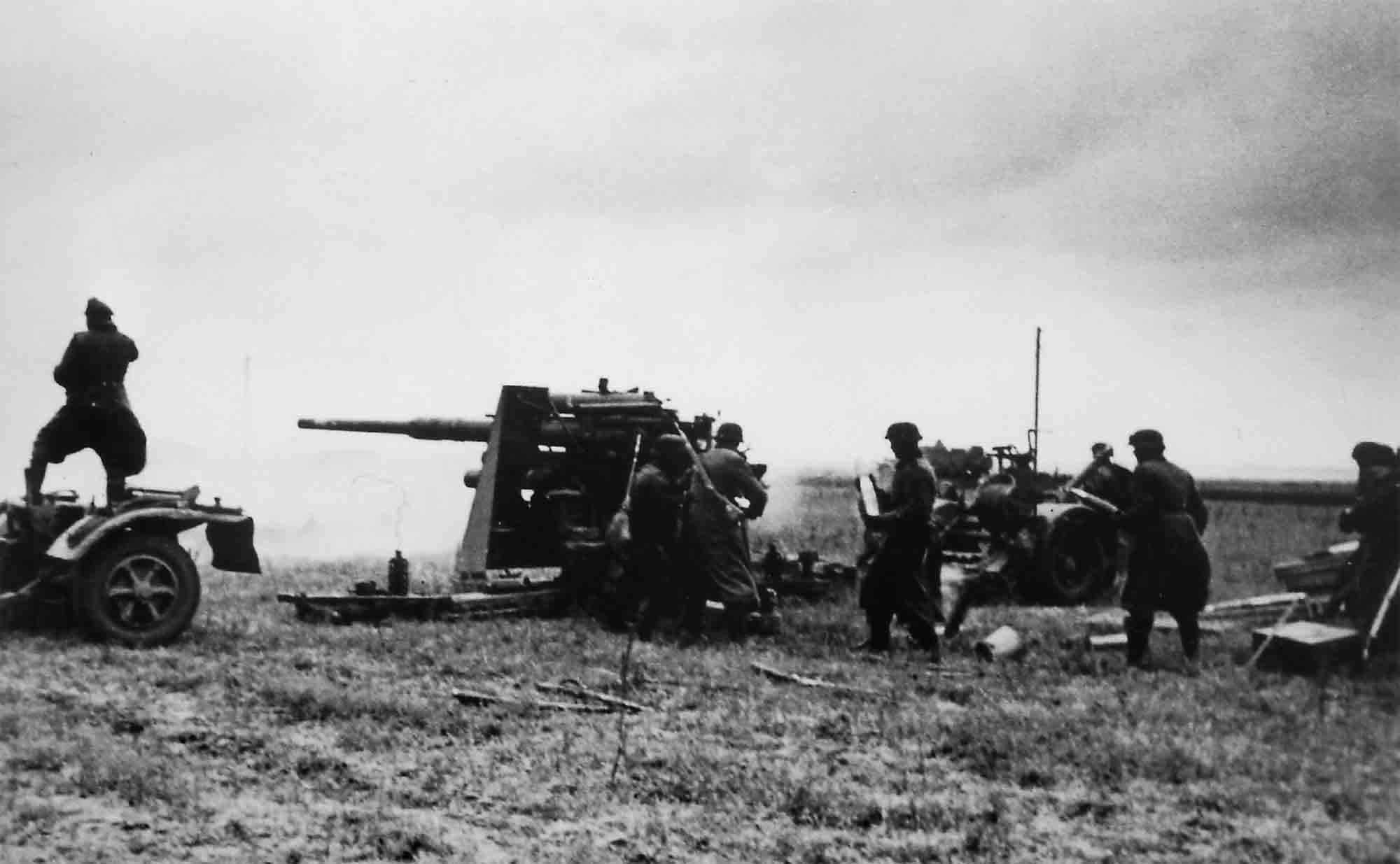

Here in this photograph is a well camouflaged Marder II Ausf.D mounting a 7.62cm PaK (r) gun.
These PaK battalions supported the main thrust and were of importance for the preparation and successful conduct of an infantry or Panzer attack. When tanks or other armoured vehicles broke through the enemy forward defence lines, artillery, FlaK and PaK designated for the support followed in unison. The mission of these units was to neutralize the enemy on the ground and in the air. In a ground role, concentration on enemy tanks in assembled areas was a priority. Adjusting fire with high explosives was also initiated on probable enemy observation posts. The task of a PaK gunner against a ground target was the destruction of advancing enemy armoured formations, and where possible, destroy enemy defensive positions.
By the end of 1942 the weight of Russian armour had almost doubled from the previous year, and there was an increased awareness of adapting and producing more PaK guns to meet the mounting peril.

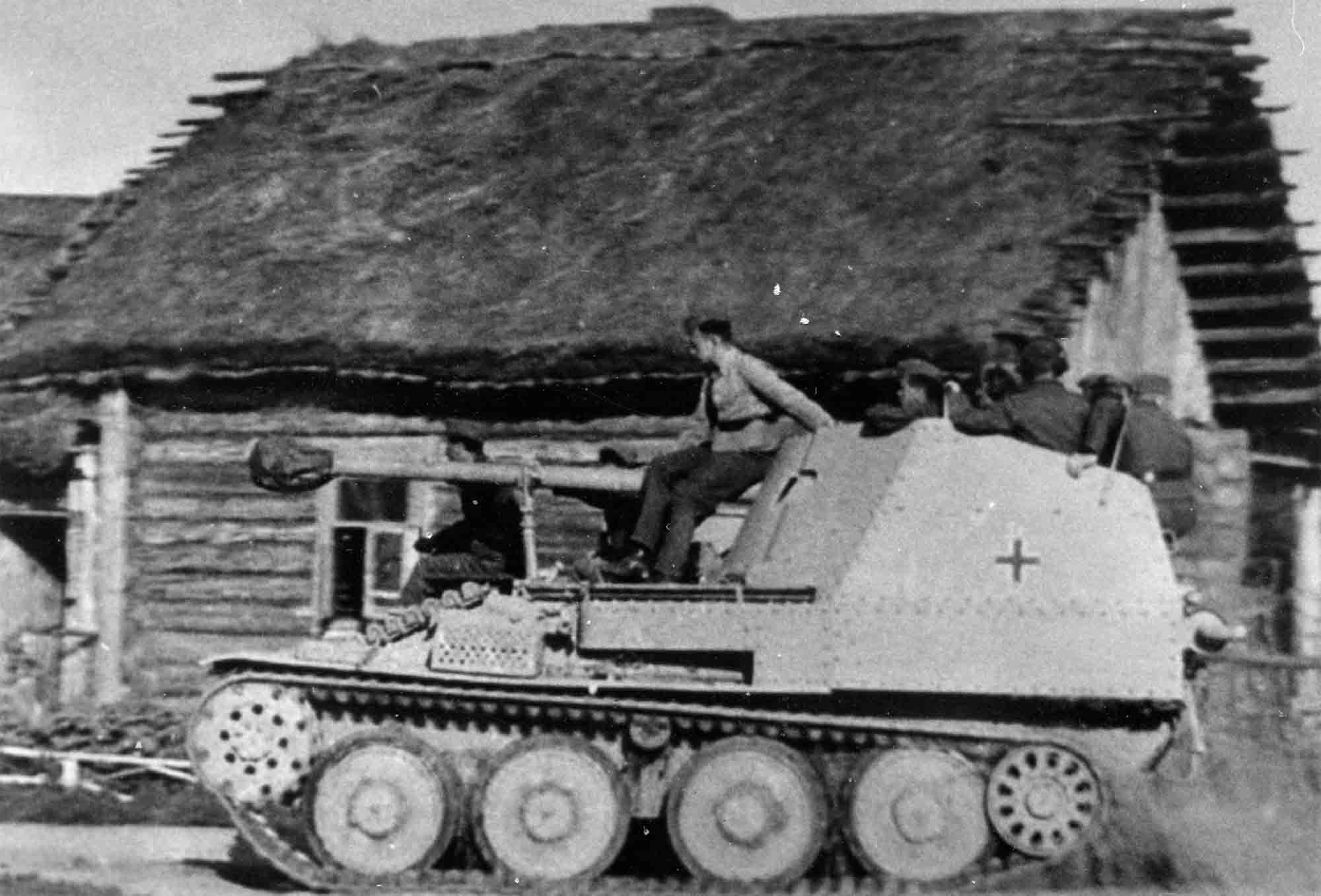
Two photographs showing a Marder III Panzerja¨ger during operations in 1942. This vehicle mounted either Soviet 76.2mm F-22 model divisional field guns, or the German 7.5cm PaK 40 anti-tank gun, in an open-topped cupola on the chassis of the Panzer 38(t). While it offered little protection to the crew, it added significant firepower. The Marder was not an assault vehicle nor was it an interim solution to a tank. Its sole purpose was to operate in urban areas or other close quarter combat situations where it could bring fire against enemy armoured vehicles. While these machines were more of a gun carriage than a proper Panzerja¨ger that could exchange shells with enemy tanks, they nevertheless undertook sterling anti-tank service for the Wehrmacht and the Waffen-SS.
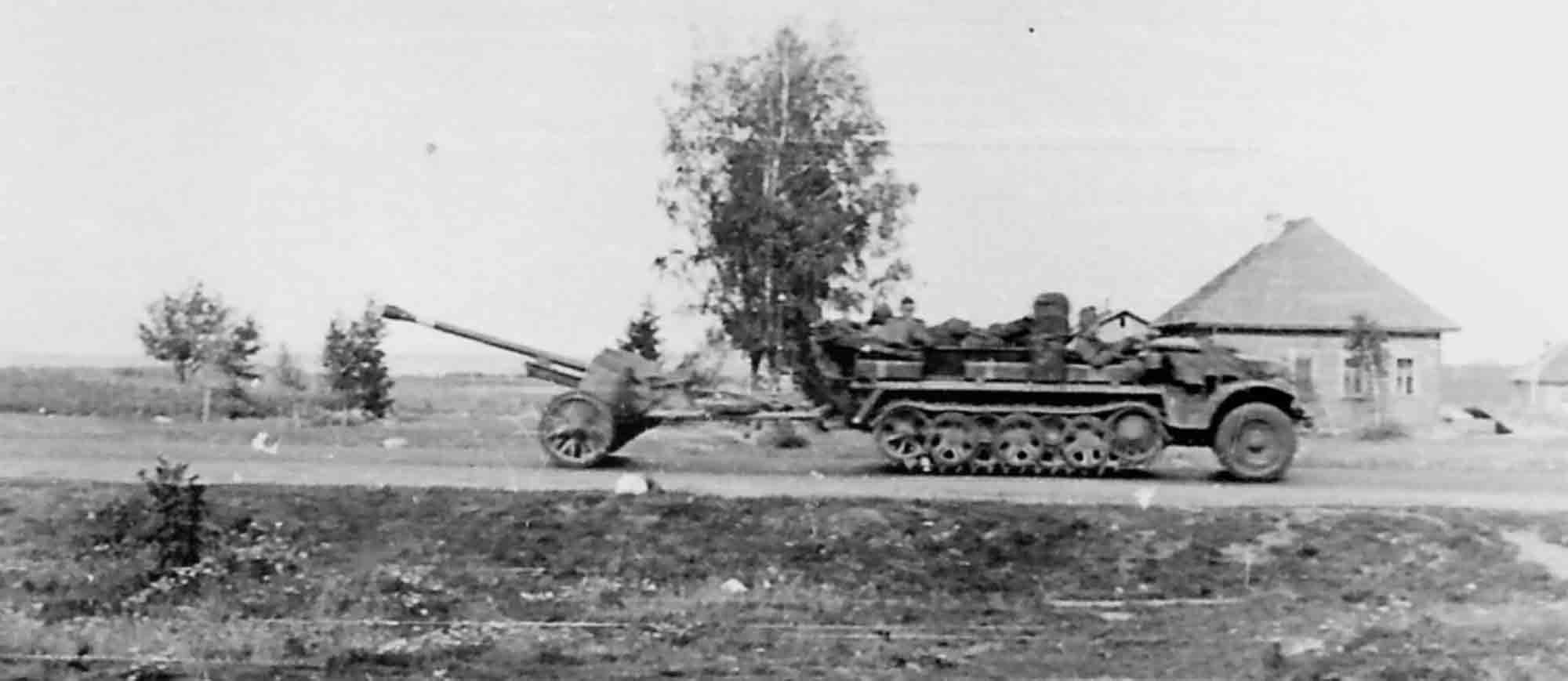
Advancing along a road is a Sd.Kfz.10 hauling a 5cm PaK 38. Note the three metal ammunition boxes on the track guards and the 20-litre jerry-can between the first and second box.
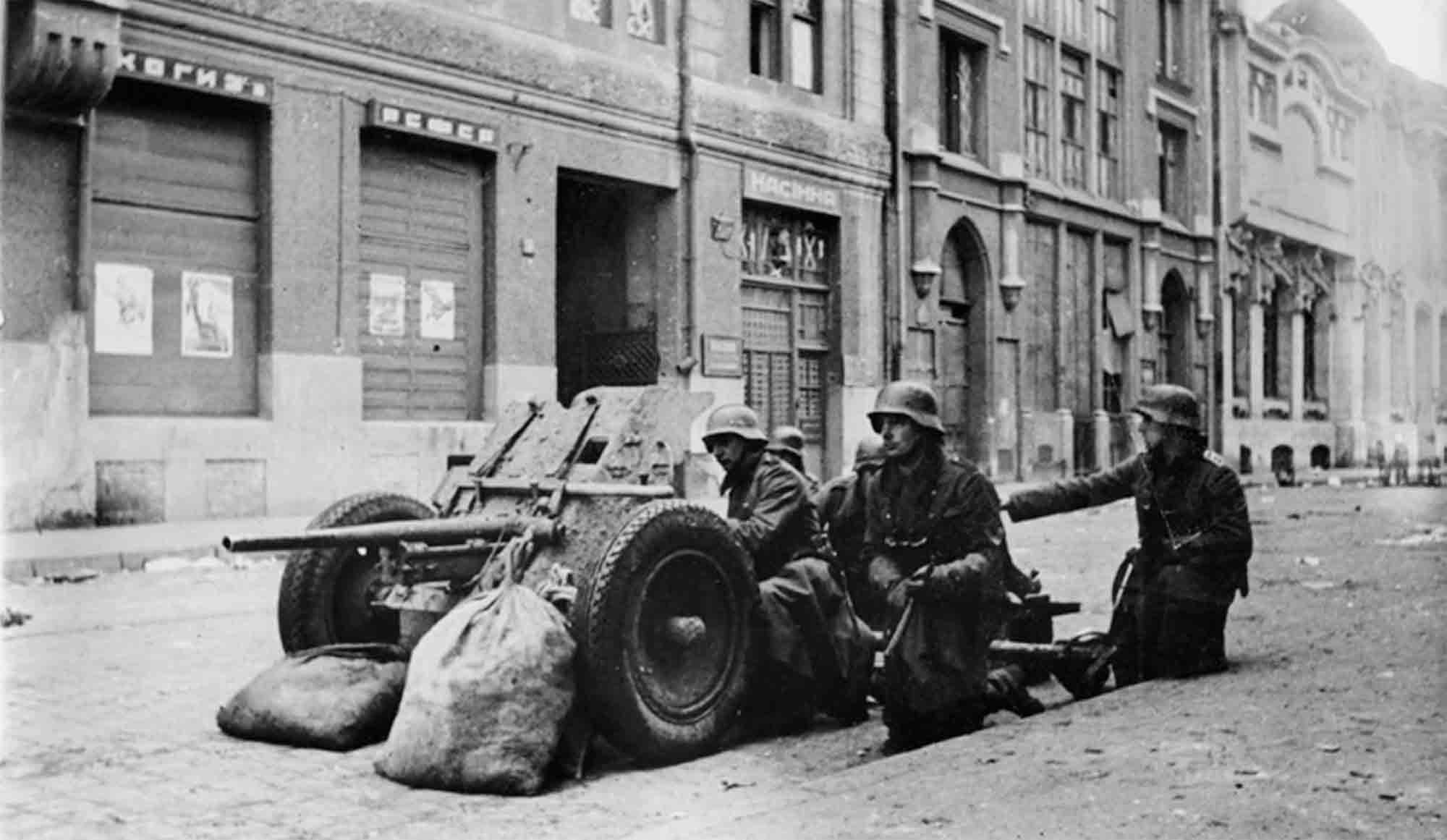

Two photographs taken in sequence showing a PaK 35/36 anti-tank gun crew in a street during the first battle of Kharkov in 1942. The Kharkov area was regarded by both German and Soviet forces as pivotal on the Eastern Front, sitting astride two important strategic axes towards Kursk and the Donbas. At Kharkov the Russians believed that they would be able to regain the initiative and achieve strategic aims by pushing the Wehrmacht back and thus begin what they thought would be the beginning of the end of the German military machine in Russia. The reality was rather different. Stalin and his commanders were over-confident and underestimated Hitler’s determination to capture what he regarded at the time as the most strategically important city in southern Russia. What followed in May 1942 was a bloody battle of attrition in which the Soviet army lost hundreds of thousands of soldiers in one of the most catastrophic offensives of Russian military history.
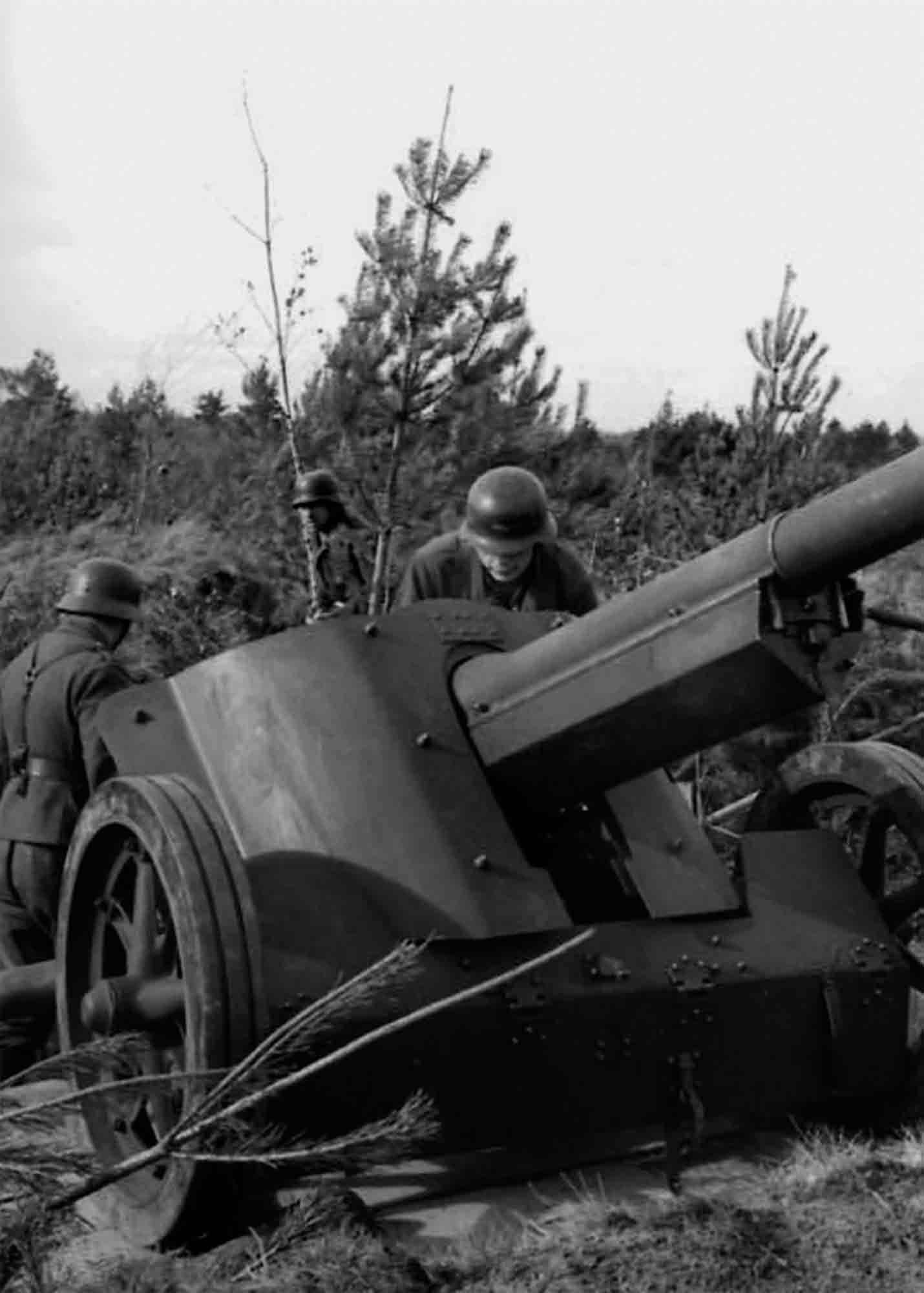
A ground Luftwaffe PaK crew manhandle their 5cm PaK 38 through some undergrowth during operations on the Eastern Front in 1942. These Luftwaffe troops fought well, supporting Wehrmacht troops both in offensive and defensive roles. Through 1942 the Luftwaffe field divisions were directly under Luftwaffe command, but continued supporting the Heer’s drive East. They defended more often than they attacked. Often Luftwaffe PaK units supported the main drive and were considered to be of decisive importance for the preparation and the successful conduct of a Panzer attack. When a tank or other armoured vehicle broke through the enemy forward defence lines, artillery and PaK designated for support followed in unison. The main task of a PaK gunner against a ground target was the destruction of advancing enemy armoured formations and, where possible, to destroy any enemy defensive positions. However, by the end of 1942 the threat from enemy armoured ground attack had almost doubled from the previous year and there was an increased awareness of adapting and producing more PaK guns in all the services to meet the mounting peril.

A 5cm PaK 38 gun crew during the battle of Stalingrad in the summer of 1942. Being exposed in the street like this meant that gunners often had to give their guns additional protection, which also helped conceal the weapon.
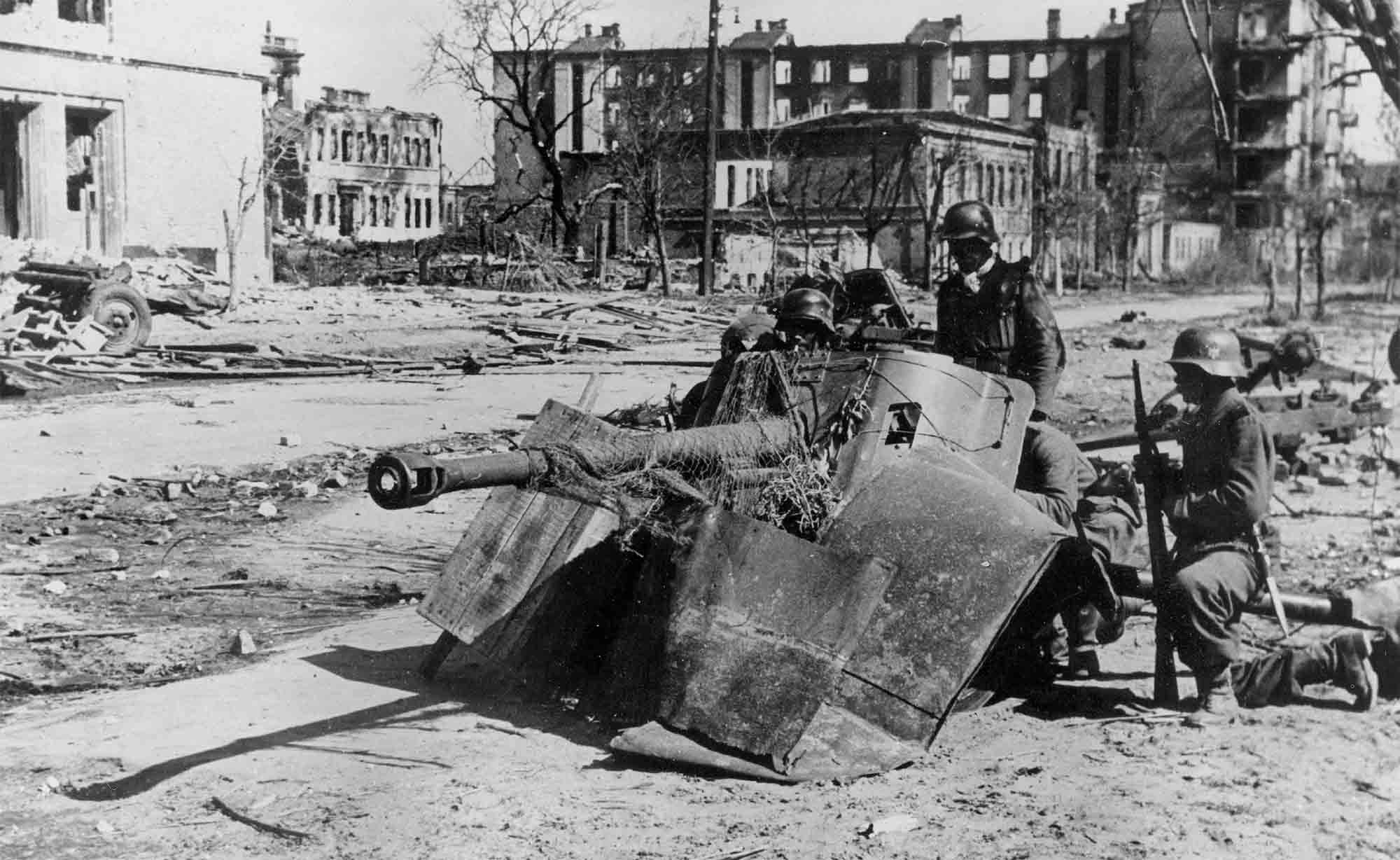
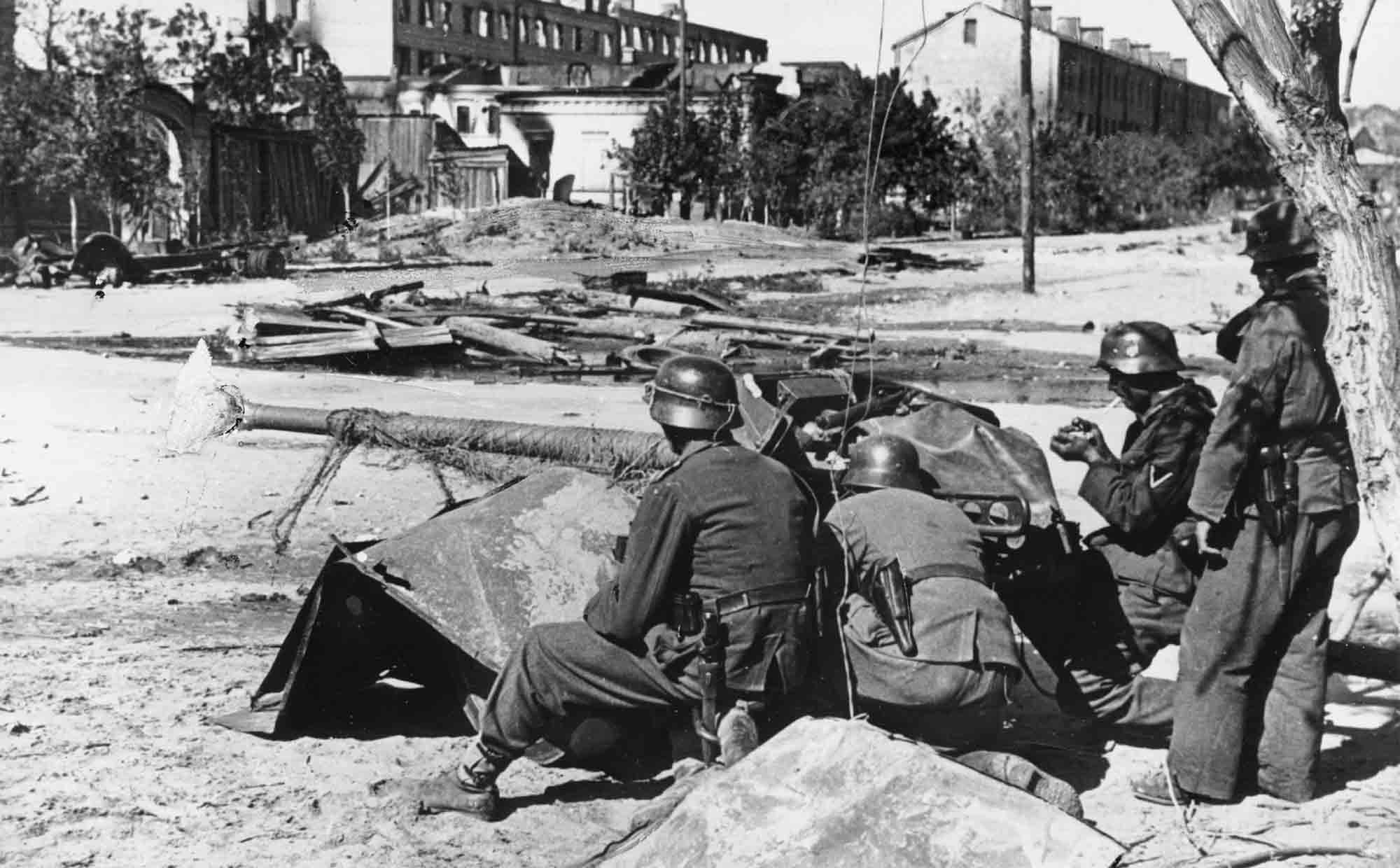
Two photographs taken in sequence showing a 5cm PaK 38 gun crew which has taken drastic measures to conceal their weapon in the bombed and blitzed city of Stalingrad in August 1942. Note how the splinter shield has been given additional armoured protection with the use of steel sheets.

During operations around Stalingrad this 5cm PaK 38 gun crew can be seen moving their weapon into another position for a fire mission. Note how the foliage to help conceal the weapon has been attached to the gun shield, as well as the custom-made canvas cover wrapped around the gun’s breech.
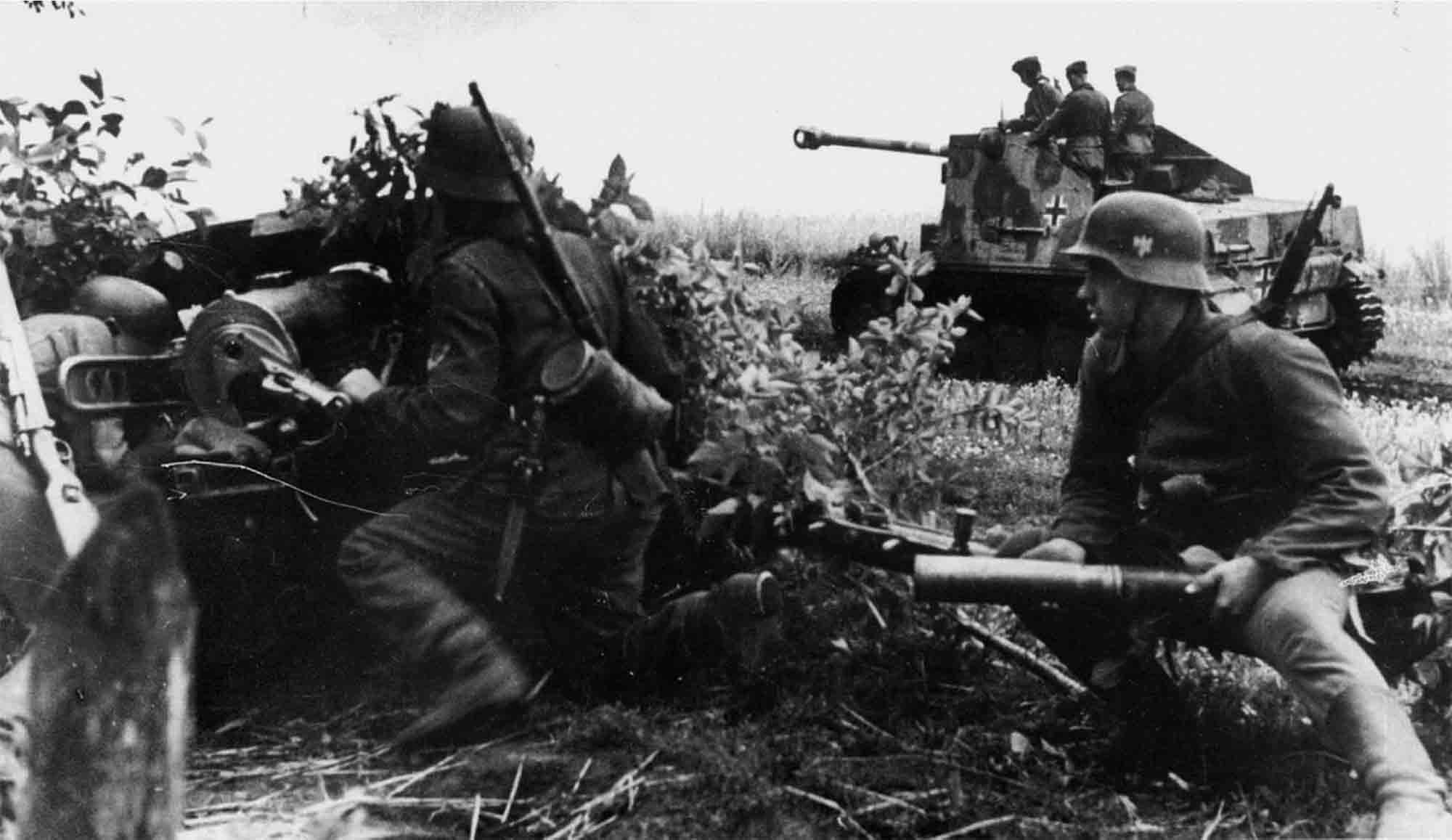
A PaK97/38 crew are seen preparing their weapon for a fire mission. Passing in the background along a dirt road is a Marder II Panzerja¨ger. This anti-tank vehicle, introduced in 1942, was the second series of the Marder. It was based on the chassis of the Pz.Kpfw.II. The first version mounted modified Soviet 7.62cm guns firing German ammunition, the other mounted the powerful German 7.5cm PaK 40 gun.

The crew of a 7.5cm PaK 40 gun prepares their weapon for a fire mission against a Soviet target. These guns were normally assigned to divisional anti-tank battalions but were often seen supporting grenadier anti-tank companies.


Two photographs taken in sequence showing the loading of an anti-tank projectile into the breech of a well concealed 7.5cm PaK 40 gun, and the gunner looking through the gun sight in preparation to fire the weapon against a Soviet target. Often anti-tank gun crews would provide what was known as a ‘over-watch’ to support tanks in the advance, since the tanks could not accurately fire while on the move.

Anti-tank gun numbers were drastically increased in mid-1942 as the Germans were met by masses of heavy Russian tanks. Production of PaK 40 was greatly augmented to form the bulk of anti-tank artillery. The Fallschirmja¨ger (paratroopers) were also given additional anti-tank guns to combat the developing threat. In this photograph a PaK 40 is manned by Fallschirmja¨ger anti-tank gunners.

Out in a field a Waffen-SS anti-tank gun crew can be seen with their 7.5cm PaK 40 during a fire mission. Note the foliage attached to the bolt heads of the splinter shield. This was common practice for anti-tank gunners.

A well camouflaged 7.5cm PaK 40 partially hidden in the tall grass during an operation. Note the protective shield for the gunner, near to the breech-block. This was designed to prevent him from being injured by enemy fire or shrapnel blasts at close range, or when the gun tube recoiled.
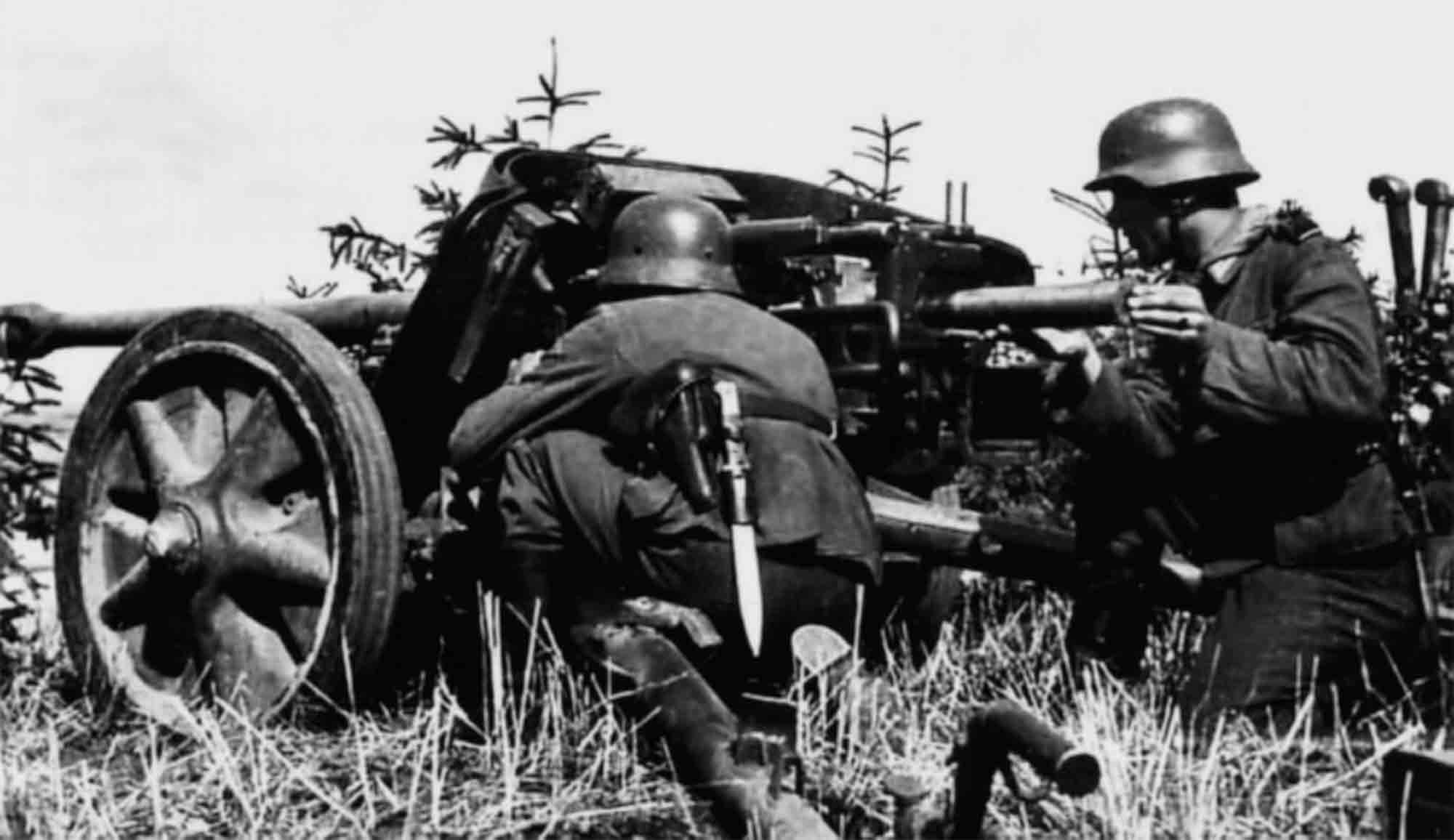
This new 7.5cm PaK 40 is being loaded for a fire mission in a field during operations on the Eastern Front in the early summer of 1942. This gun was an enlarged version of the PaK 38, using a similar split-trail carriage and a double-skinned splinter shield. It became the standard German anti-tank weapon, remaining in service throughout the war.

While it appears that this 5cm PaK gun crew are involved a fire mission against an enemy target, as they are not wearing helmets it is more likely they are training before moving off to the front. Crews often trained just to the rear of the front lines, as it was deemed that the men would be fresh from training for active combat.
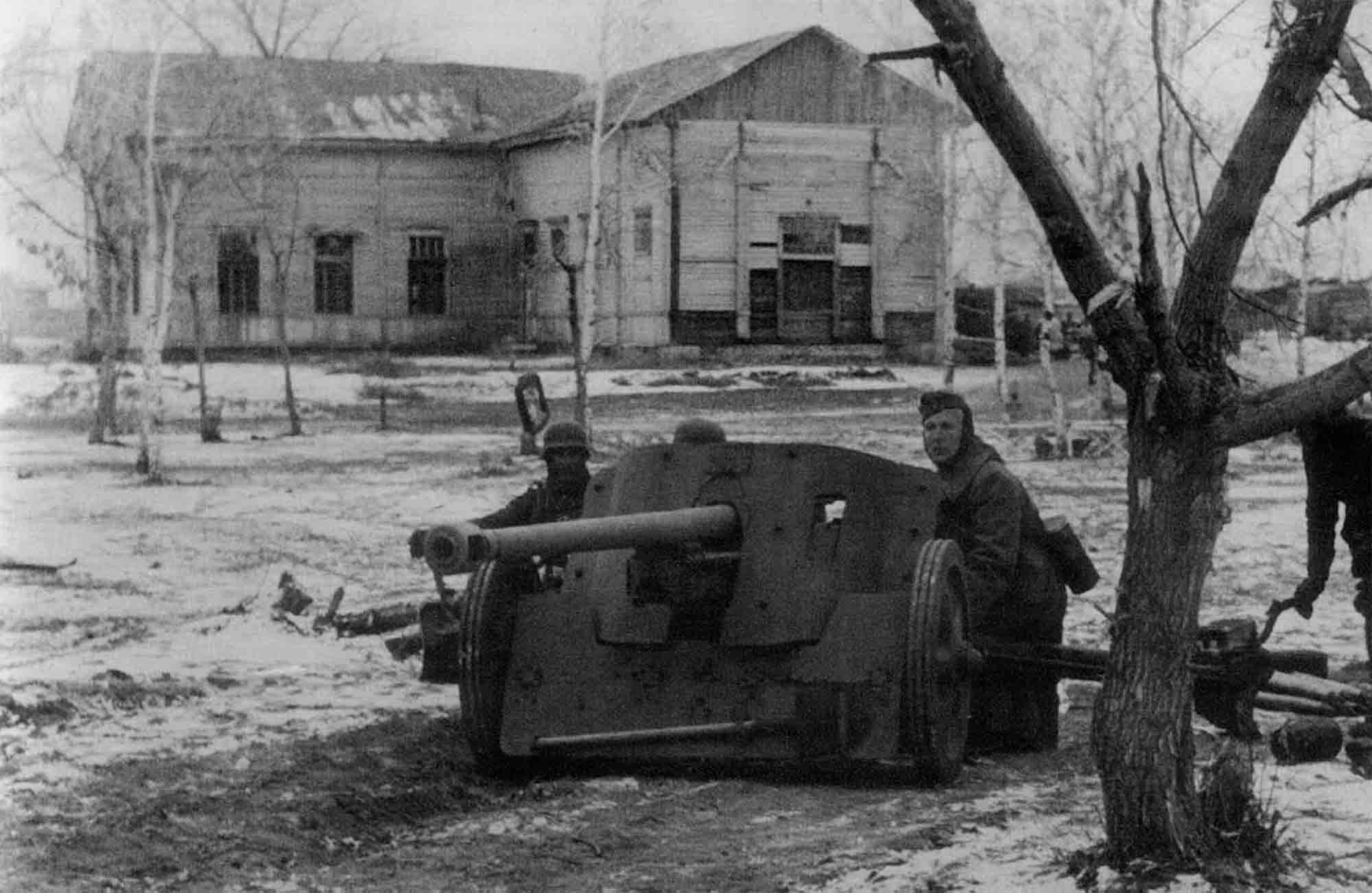
In winter 1942 a 7.5cm PaK 40 gun crew can be seen positioned in a town during operations on the Eastern Front. By this period of the war PaK guns were being used in their thousands on various sectors of the Eastern Front and saw some fierce fighting. For the time being, the Germans maintained more or less the strategic initiative on the Eastern Front.

Along a road somewhere on the Eastern Front a column of horse-drawn vehicles are hauling supplies to the front during operations in 1942. Note the PaK 35/36 being moved by animal draught, which was typical during this early period of the war in Russia.

Preparing their PaK 38 for firing is a gun crew out in a field. Four of the men are wearing mosquito nets over their M35 steel helmets. During the German advance, especially through northern and central Russia, soldiers found the surrounding swamplands to be infested with flies and mosquitoes.